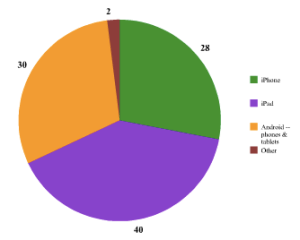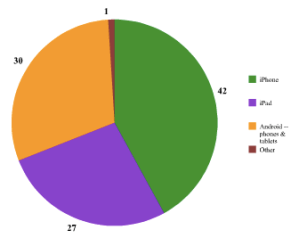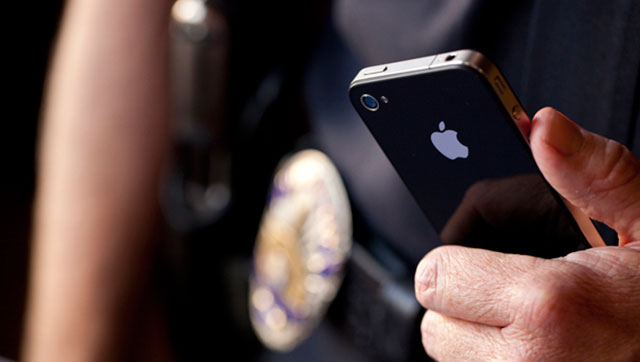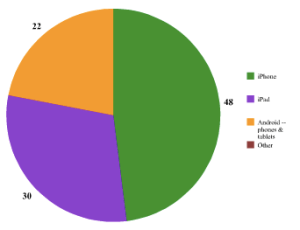Apple’s iOS is consolidating its grip on the enterprise market and taking share from Android, according to customer data from enterprise file sharing and hybrid cloud storage company Egnyte, which offers cloud back-up and storage services for a mix of customers, from large corporates with thousands of seats to SMEs with just a handful.
Of course different enterprises have very different needs and requirements when it comes to mobile devices. Take a look at governments, for instance, and you’d be convinced BlackBerry is still killing it. But as a snapshot of the mobile OSes being favoured by different sized companies, mostly U.S.-based (80 percent of the data, with the other 20 percent pertaining to European businesses), this data is an interesting subset to add to the pile.
The data, shared directly with TechCrunch, covers 100,000 of Egnyte’s paying customers over the last year-and-a-half+, tracking which OS they are using to access its services on mobile devices and also splitting out iPhone and iPad use. The numbers look strong for Apple, with the iPhone especially growing its proportion of users since the second half of 2011 to-date — perhaps helped by the halo effect of iPads arriving in the enterprise and persuading business folk to trade their BlackBerrys for iPhones. Egnyte’s data doesn’t specifically refer to BlackBerrys but does show Apple taking share away from Android.
“Apple seems to have at least temporarily won the hearts and minds of business users with its products accounting for about 70 percent of our traffic,” Egnyte told TechCrunch.
In Q3/Q4 2011, Egnyte’s data shows the following device breakdown — giving iOS a 68 percent majority of Egnyte’s enterprise user-base:
- iPhone 28%
- iPad 40%
- Android 30% (phones and tablets)
- other 2%
In 2012, the iPhone grew its proportion, while the iPad’s very sizeable share shrank to below a third — suggesting iPhone usage cannibalised iPad usage to an extent. Overall, though, Apple’s percentage rose to 69 percent:
- iPhone 42%
- iPad 27%
- Android 30% (phones and tablets)
- other 1%
Egnyte has also scraped some early data for Q1 2013, which shows both iPhone and iPad usage rising — this time apparently at the expense of Android phones and tablets, which had previously held a steady share of 30 percent. There is also no sign as yet of a Microsoft enterprise mobile resurgence with its Windows Phone OS (the ‘other’ catch-all category doesn’t yet figure in the 2013 data). Apple holds a whopping, ‘Pacman-shaped’ 78 percent share of the user base as of Q1 2013:
- iPhone 48%
- iPad 30%
- Android 22% (phones and tablets)
Egnyte’s data on enterprise users’ preference for iPhones tallies broadly with data from mobile device management company Good Technology, covered recently by CITEworld. Good reported even higher percentages for iOS — with nearly 77 percent of devices activated by its corporate customers in Q4 2012 powered by iOS, up from 71 percent in the fourth quarter of 2011. Good also found Android’s enterprise mobile shared declining, dropping to 22.7 percent in Q4 2012, down from 29 percent in Q4 2011. (It also tracked a 0.5 percent rise for Windows Phone.)
Returning to Egnyte’s data for 2012, almost a fifth (19 percent) of the Android traffic was generated using a Nook tablet — so despite the iPad’s popularity with business users, some enterprises are evidently not immune to the lure of using cheaper tablet hardware.
The company also breaks out Wi-Fi access by device for 2012. It found that 40 percent of iPad sessions occurred over Wi-Fi, while just 31 percent of iPhone sessions did — suggesting the iPhone still prevails as the device of choice in the most mobile situations, ie when users are moving around a lot or aren’t in range of a Wi-Fi network (perhaps because businesses have purchased Wi-Fi only iPads to keep ongoing costs down).
Egnyte speculates that smartphones are fractionally quicker to begin using than tablets, typically sitting within easy reach, so tend to be the device of choice for viewing files on the fly, with users waiting for a more comfortable environment before getting out the tablet to do some editing. “Overall, tablet use in the corporate marketplace hasn’t been as high as we would expect, but… we think this may be more due to people’s love affairs with their phones, than for any lack in the capabilities of a tablet,” the company said.
Commenting generally on the data, Egnyte told TechCrunch:
While initially iPads dominated our use, iPhones have taken over. 2011 use showed the iPad accounting for 40 percent of our usage, in 2012 iPhones are now 42 percent of usage, and Android has remained constant at about 30 percent of use. There are two interesting points here, first, Apple seems to have at least temporarily won the hearts and minds of business users with its products accounting for about 70 percent of our traffic. This is important because it’s a flip-flop from the days of old, where Apple products were rarely seen in the corporate landscape. It’s also an indication that when BYOD wrested control over what devices consumers used from IT, they overwhelmingly chose an easy to use product that focused on UI and usability, perhaps even at times over depth.
The second interesting point is that while tablets are certainly hot, iPhones are driving most of the traffic. This may be due to the fact that the iPad doesn’t replace a laptop yet as the corporate device of choice, but try and take a business person’s smartphone away from them, and you may not have a hand left. Smartphones are a must have, and we suspect that since people are already checking email on such a phone while they are working remotely, it’s an extra step to get out and bootup your tablet, so if you have a great phone app that does the same thing, just use it to view your files. Most editing we think still happens on the laptop/desktop. This ‘on the go’ access is further confirmed by the fact that only 31 percent of iPhone sessions occurred over Wi-Fi, that means over three-quarters of access happens via cellular services.

